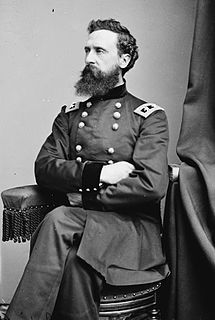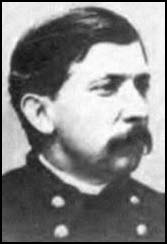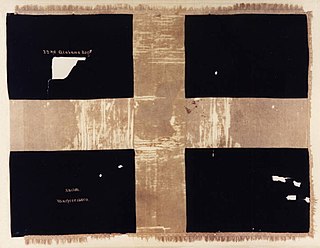The 50th Georgia Infantry Regiment was an infantry regiment raised by the state of Georgia to fight for the Confederacy in the American Civil War.

George Sykes was a career United States Army officer and a Union General during the American Civil War.

Loyd Wheaton was a United States general who fought in the Philippine–American War and in the Union Army during the American Civil War.

James William Forsyth was a U.S. Army officer and general. He was primarily a Union staff officer during the American Civil War and cavalry regimental commander during the Indian Wars. Forsyth is best known for having commanded the 7th Cavalry at the Wounded Knee Massacre on December 29, 1890 during which more than 250 men, women, and children of the Lakota were killed and more than 50 were wounded.
Levi Clark Bootes was a career officer in the United States Army, serving in the Mexican–American War and the American Civil War.
Cobb's Legion was an American Civil War unit that was raised on the Confederate side from the State of Georgia by Thomas Reade Rootes Cobb during the summer of 1861. A "legion" consisted of a single integrated command, with individual components from the infantry, cavalry, and artillery. When it was originally raised, the Georgia Legion comprised seven infantry companies, four cavalry troops, and a single battery. The concept of a multiple-branch unit was fine in theory, but never was a practical application for Civil War armies and, early in the war, the individual elements were assigned to other organizations.

The 2nd Connecticut Heavy Artillery Regiment was a volunteer infantry regiment which served in the Union Army during the American Civil War.

Charles Augustus Wikoff was a United States Army officer serving from American Civil War until he became the most senior ranking American Army officer killed in the Spanish–American War.
The 9th Iowa Infantry Regiment was an infantry regiment that served in the Union Army during the American Civil War.

The 22nd Alabama Infantry Regiment was an infantry regiment that served in the Confederate Army during the American Civil War.

George Maltby Love was a colonel in the Union Army and a Medal of Honor recipient for his actions in the American Civil War.

John Horace Forney was a major general in the Confederate States Army during the American Civil War.

William Henry Talbot Walker was an American soldier. He was a career United States Army officer who fought with distinction during the Mexican-American War, and also served as a Confederate general during the American Civil War. Walker was severely wounded many times in combat, and was killed in action during the 1864 Atlanta Campaign.

Charles Robert Woods was a career United States Army officer and a Union general during the American Civil War. He is noted for commanding the relief troops that first attempted to resupply Fort Sumter prior to the start of the conflict, and served with distinction during the war.

Field Marshal Lord William Paulet, was a senior British Army officer. During the Crimean War he served as Assistant Adjutant-General of the Cavalry Division, under Lord Lucan, at the Battle of Alma in September 1854, at the Battle of Balaklava in October 1854 and at the Battle of Inkerman in November 1854 as well as at the Siege of Sevastopol during the Crimean War. He was then given command of the rear area, including the Bosphorus, Gallipoli and the Dardanelles before returning to England. He later became Commander of the 1st Brigade at Aldershot in 1856, General Officer Commanding South-West District in 1860 and finally Adjutant-General to the Forces in 1865.
The 1st Missouri Infantry was an infantry regiment that served in the Confederate States Army during the American Civil War. Originally commanded by Colonel John S. Bowen, the regiment fought at the Battle of Shiloh, where it was engaged near the Peach Orchard on April 6, 1862. On April 7, during the Union counterattacks at Shiloh, the regiment was instrumental in preventing the Washington Artillery from being captured. The regiment was next engaged at the Second Battle of Corinth, where it outflanked several Union positions. On the second day at Corinth, the regiment was only minimally engaged. On November 7, the 1st Missouri Infantry was combined with the 4th Missouri Infantry to form the 1st and 4th Missouri Infantry (Consolidated), as a result of heavy battle losses in both regiments.
The 8th Arkansas Infantry Battalion (1862–1865) was a Confederate Army infantry regiment during the American Civil War. The unit was sometimes referred to in contemporary sources as "(Jones’) First Arkansas Battalion” and "(Miller’s) 2nd Arkansas Battalion.”

The 11th Regiment Illinois Volunteer Infantry was an infantry regiment from Illinois that served in the Union Army during the American Civil War. In April 1861, it was formed as a three-month volunteer unit, and in July 1861 it was reorganized as a three-year unit, in which role it served until the end of the war. Two of its commanding officers were promoted to brigadier general and led major units during the war. In its first major action at Fort Donelson the regiment suffered terrible losses. The 11th Illinois also fought at Shiloh, Riggins Hill, Vicksburg, First Yazoo City, Second Yazoo City, and Fort Blakely. In April 1863, the 109th Illinois Infantry Regiment was disbanded and its enlisted men transferred into the 11th Illinois. The regiment was mustered out of service in July 1865.
Joseph Nelson Garland Whistler was a career United States Army officer. He served in the Mexican–American War and received a brevet appointment for distinguished service in the Battle of Contreras and the Battle of Churubusco. At the beginning of the American Civil War, Whistler was among the U.S. Regular Army officers taken prisoner by Confederates in Texas in April 1861 and paroled but was not exchanged until August 15, 1862. In 1863, he became colonel of the 2nd New York Heavy Artillery Regiment. He received a promotion and four brevet appointments in the regular army for his service during the Overland Campaign, specifically the Battle of North Anna, and the Siege of Petersburg, specifically the Second Battle of Petersburg. He was nominated on January 13, 1866 and confirmed on March 12, 1866 for appointment to the grade of brevet brigadier general of volunteers, to rank from March 13, 1866. He retired in on October 19, 1886 as colonel of the 15th U.S. Infantry Regiment.
James Henry Toole served four terms as mayor of Tucson, Arizona. The first two terms were 1873 and 1874. The second two terms were 1878 and 1879.











